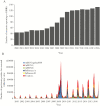The Global Threat of Animal Influenza Viruses of Zoonotic Concern: Then and Now
- PMID: 28934463
- PMCID: PMC7313897
- DOI: 10.1093/infdis/jix331
The Global Threat of Animal Influenza Viruses of Zoonotic Concern: Then and Now
Abstract
Animal influenza viruses can reassort or mutate to infect and spread sustainably among people and cause a devastating worldwide pandemic. Since the first evidence of human infection with an animal influenza virus, in 1958, 16 different novel, zoonotic influenza A virus subtype groups in 29 countries, Taiwan, and Hong Kong have caused human infections, with differing severity and frequency. The frequency of novel influenza virus detection is increasing, and human infections with influenza A(H5N1) and A(H7N9) viruses are now annual seasonal occurrences in Asia. The study of the epidemiology and virology of animal influenza viruses is key to understanding pandemic risk and informing preparedness. This supplement brings together select recent articles that look at the risk of emergence and transmission of and approaches to prevent novel influenza virus infections.
Keywords: Influenza; global; novel; pandemic; zoonotic.
Published by Oxford University Press for the Infectious Diseases Society of America 2017. This work is written by (a) US Government employee(s) and is in the public domain in the US.
Figures

Similar articles
-
Antigenic and genetic characteristics of zoonotic influenza viruses and development of candidate vaccine viruses for pandemic preparedness.Wkly Epidemiol Rec. 2015 Oct 16;90(42):561-71. Wkly Epidemiol Rec. 2015. PMID: 26477059 English, French. No abstract available.
-
The next influenza pandemic: lessons from Hong Kong.J Appl Microbiol. 2003;94 Suppl:70S-79S. doi: 10.1046/j.1365-2672.94.s1.8.x. J Appl Microbiol. 2003. PMID: 12675938
-
A review of simulation modelling approaches used for the spread of zoonotic influenza viruses in animal and human populations.Zoonoses Public Health. 2013 Sep;60(6):383-411. doi: 10.1111/zph.12010. Epub 2012 Sep 3. Zoonoses Public Health. 2013. PMID: 22937896 Review.
-
Influenza A (H5N1) in Hong Kong: an overview.Vaccine. 2002 May 15;20 Suppl 2:S77-81. doi: 10.1016/s0264-410x(02)00137-8. Vaccine. 2002. PMID: 12110265
-
Emerging influenza viruses and the prospect of a universal influenza virus vaccine.Biotechnol J. 2015 May;10(5):690-701. doi: 10.1002/biot.201400393. Epub 2015 Mar 2. Biotechnol J. 2015. PMID: 25728134 Review.
Cited by
-
Missing: Where Are the Migrants in Pandemic Influenza Preparedness Plans?Health Hum Rights. 2018 Jun;20(1):251-258. Health Hum Rights. 2018. PMID: 30008567 Free PMC article. No abstract available.
-
ProbeTools: designing hybridization probes for targeted genomic sequencing of diverse and hypervariable viral taxa.BMC Genomics. 2022 Aug 12;23(1):579. doi: 10.1186/s12864-022-08790-4. BMC Genomics. 2022. PMID: 35953803 Free PMC article.
-
Characterization of highly pathogenic avian influenza H5Nx viruses in the ferret model.Sci Rep. 2020 Jul 29;10(1):12700. doi: 10.1038/s41598-020-69535-5. Sci Rep. 2020. PMID: 32728042 Free PMC article.
-
Comparative evolution of influenza A virus H1 and H3 head and stalk domains across host species.mBio. 2024 Jan 16;15(1):e0264923. doi: 10.1128/mbio.02649-23. Epub 2023 Dec 11. mBio. 2024. PMID: 38078770 Free PMC article.
-
The Dual Role of CCR5 in the Course of Influenza Infection: Exploring Treatment Opportunities.Front Immunol. 2022 Jan 20;12:826621. doi: 10.3389/fimmu.2021.826621. eCollection 2021. Front Immunol. 2022. PMID: 35126379 Free PMC article. Review.
References
-
- Koen JS. A practical method for field diagnosis of swine disease. Am J Vet Med 1919; 14:468–70.
-
- Zimmer SM, Burke DS. Historical perspective—emergence of influenza A (H1N1) viruses. N Engl J Med 2009; 361:279–85. - PubMed
-
- Kluska V, Macku M, Mensik J. Demonstration of antibodies against swine influenza viruses in man. Cesk Pediatr 1961; 16:408–14. - PubMed
-
- Pawlisch R, Easterday BC, Nelson DB, Skinner HG, Levy ME. Influenza - Wisconsin and Washington, D.C. MMWR Morb Mortal Wkly Rep 1976; 25:593.
-
- Jernigan DB, Cox NJ. Human influenza: one health, one world. In: Webster RG, Monto AS, Braciale TJ, Lamb RA, ed. Textbook of influenza. 2nd ed Hoboken, NJ: John Wiley and Sons, 2013:3–19.
Publication types
MeSH terms
LinkOut - more resources
Full Text Sources
Other Literature Sources
Medical

